Copyright © University of Cambridge. All rights reserved.
'Path of Discovery Series: 2. First Steps' printed from https://nrich.maths.org/
Show menu
Last time (Uncertain Beginnings) we looked at how the learning of mathematics can be compared with following a meandering path of crazy paving. There are many stones, each providing its own perspective on the maths we have already learnt, and enabling us to make varied routes through the wealth of knowledge that
lies before us.
A path of crazy paving doesn't start with one particular stone, and our knowledge of the mathematical world doesn't start with one particular activity. Children explore shape and space from their very first days. They learn to recognise the shape of their parents' faces. They learn where the edge of the buggy is so they can drop things to be picked up. And they learn which gaps are wide enough to
crawl through, and which aren't. They explore their world with all their senses, to find out about the objects around them. Gradually they encounter the vocabulary of mathematics, through nursery rhymes and songs, as well as by hearing words like 'round', 'square', 'longer', 'smaller', etc., etc. in everyday conversation.
Children learn and consolidate what they know through play. This article will take a closer look at some of the toys and games that can enhance a child's mathematical learning. Scroll down to find more detailed explanations of each one.
Toys and games
The range of toys and games which use mathematical processes increases all the time. Whether you use modern board games or traditional toys, they all provide opportunities for children to learn about mathematics in a natural and enjoyable way.
The counting frame: Often regarded as a 'baby toy', the counting frame is a powerful teacher of number. It can be used for simple counting, visualising numbers and number bonds.
Shapes and building blocks: Simple geometric shapes and blocks promote an understanding of shape, and the properties of certain shapes. Being able to handle the shapes also helps the children to learn about balance and improve their fine motor skills.
Dominoes: Dominoes can be used for simple matching games, and can be an aid in the learning of number and recognition of numerals.
Board games: Board games involving the use of dice help with the understanding of number, counting, and begin the development of mental arithmetic.
Card games: An ordinary pack of cards or commercial card games can be used to enhance matching, number recognition, counting and arithmetic.
Jigsaws and puzzles: From very simple shape sorters to complicated three-dimensional puzzles, jigsaws and puzzles provide a wealth of opportunities to practise and improve spatial awareness.
There is one more bonus that follows from playing these games: children learn that winning is fun but that losing is part of life as well. If you can show them that you can 'cope' with bad luck, or that you made a silly mistake which ultimately lost you the game, they too will accept a game for what it is, and not get upset if they aren't always the winner.
Real life
As well as learning about the mathematical world through play, children encounter mathematical concepts through everyday activities. By involving children as we do things, we can demonstrate what words like 'more', 'fewer' 'too long', 'how many?', 'cost', 'half', 'heavy', etc., etc. mean.
All through the day, adults are making decisions, and taking actions based upon some kind of mathematical knowledge. The action may seem too trivial to even be talked about. For example, why cut off the end of a piece of paper?, why lay five knives and forks on the table?, why give the shop assistant two pound coins?. If, however, time and patience can be employed in allowing children to be aware of these simple tasks and decisions, the vocabulary of mathematics and science becomes a natural part of every child's life. By enabling children to hear and use such vocabulary, it is less likely to hold any mystique or create any anxiety when it is used in a mathematics lesson.
Playing games with children starts at a very early age, but the toys and games mentioned here could be used by practitioners in Early Years classrooms as well as by parents at home. Enjoyment of playing games continues beyond these first years, and teachers of older children will also find the games useful. They could be used in small group situations, or as ideas to include in clubs and activities used to cultivate a home-school partnership in the promotion of mathematics.
The counting frame
Firstly, of course, the children can just count the beads on a row.
- They can move one bead as they count it, to promote one-to-one counting.
- Having mastered accurate counting to ten they can use two rows to reach twenty.
- The beads are 'trapped' on the wire, so no matter how little dexterity the child has, the beads can't run away and get muddled.
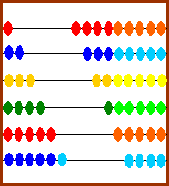
Alternatively the beads can be arranged in steps, increasing from one on the first row, two on the second, etc.
- Now when the children count down the rows they can see how each number stands for one more object than the previous number.
- Reversing the pattern enables them to count backwards and they meet the decreasing nature of the numbers.
- As they count the beads they find they are neatly packaged in tens. They notice the last bead on a row is a '....ty', and now they can count in tens!
- Further, because they are 'seeing' the numbers as they count, they begin to understand the number system -- we count to '....ty-nine' and then start the next '....ty'.
- They can show 'thirty-four' by whizzing whole rows along the wire, 'ten, twenty, thirty' and then counting four more.
- The children can move beads in batches now, no longer needing to count each individual bead -- they've started to notice number bonds -- 2 and 2 is 4, 2 and 3 is 5, 3 and 1 is 4, etc.
And, although they probably won't consciously use these facts for several years, the five/five split of the beads on each row has subtly shown, for example, when you separate four beads from the ten, you are left with five and one more at the other end, that seven beads is made from five and two and leaves three at the other end, etc., etc.
Pretty high-powered stuff for just a 'baby toy'!
Shapes and building blocks
With a set of blocks made from simple geometric shapes, children can explore balance and the possibilities of building, either intricate facades or more simple towers.
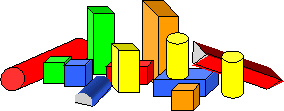
- They can use the shapes as templates and draw around them to make patterns and pictures.
And they can practise tessellation by getting the shapes to fit neatly back into the box!
Dominoes
Traditionally dominoes have patterns of spots on each end. While there is no reason why the spots cannot be treated as patterns in their own right, and not necessarily related to number at the outset, many adults prefer to introduce children to dominoes through picture matching.
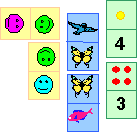
- It is especially helpful if the adult 'thinks out loud' when it is his turn and explains to the child which pictures (or colours) he is looking for.
A complete set of dominoes may make the game too long for very young children, so start off by using just a few of the set, and gradually build up the number of dominoes used in the game.
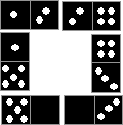
To be sure the game is playable choose dominoes that can be arranged in a ring. Then, no matter which domino is played first, someone will have a domino which can be attached. As the ability and attention span of the child/children increases, more dominoes can be used in a game. It is preferable that a very short game is played through with enjoyment, than a full game is started and then left unfinished.
Pictures and colours can be used to introduce the idea of matching. Domino sets with pictures and spots allow you to introduce the idea of numbers and matching numbers.
- 'Traditional' sets with all spots can also be found in coloured versions, so be aware that the child might be matching the colours rather than the number of spots.
Sets which include figures (numerals) are in fact taking the matching game one step further, as they use symbols for the amounts shown, rather than a simple representation in the form of spots. No reason not to use them, but remember, although the numerals are second nature to you, they are unfamiliar to the child and he is still learning to relate a certain squiggle to a certain number of objects.
You may also find our Dominoes Environment useful.
Board games
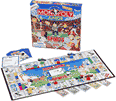
- Use a dice with spots. Say, and encourage the children to say, the number that is thrown and count out the moves on the board. All this reinforces what numbers are all about.
- If the board has numbered squares announce the number you have landed on, as this helps with number recognition.
- Using two dice helps to establish some number bonds.
- When a game is nearing its end, or if the board has 'reward' and 'penalty' squares along the route, children will instinctively 'work out' what number they need to throw -- an example of mathematical thinking occurring naturally!
A game may have rules which are too difficult for very young children to cope with. Make up your own rules and play a simple race game until the children are ready and able to make the game more interesting with tactics, penalties, etc.
Snakes and ladders is often quoted as a game for young children, but it can get very frustrating and with a run of bad luck, may go on for too long. Ludo , which is often thought of as a simple game can get quite intense if the rules for barriers and double barriers are employed. Again this can be a long game, so reduce the number of counters each player has. Some of the games which we have found particularly enjoyable, for adults and children are: Splat! , Mouse Trap and Ghost Castle by MB Games , Tower of Terror and Open the Bridge by Spears , and Road Safety Game by Early Learning Centre . These games can be played as simple races until the children are ready to understand more complicated rules. The mixture of chance and tactics keeps the games interesting for all levels of ability, and ensures the games are used over and over again.
- Rather than counting pairs, you might choose to count how many cards you have at the end -- thus enabling you to practise counting in twos.
- The game can be played with a normal pack of cards (matching numbers to make the pairs) or you can purchase specially produced packs with pictures on different themes (animals, people, vehicles, etc., etc.)
- There are other games available which are a variation on the same theme, where you use the pictures you collect to make a larger picture, for example, Finders Keepers by Big Box .
There are many children's games that can be played with a normal pack of cards.
Switch
- Each person has seven cards. The first lays down a card and the next has to follow it with a card of the same suit or the same number/picture. If he changes the suit he calls 'Switch!'
- If he cannot go, he picks up another card from the pile of undealt cards. (He may play this card if he can.)
- The winner is the first person to have no cards left in his hand.
- UNO (Waddingtons ) is a very similar game to Switch!, and helps with number and colour recognition.
Sevens (or Donkey)
- All the cards are dealt out.
- The person with the seven of diamonds starts by laying it down in the centre of the table.
- The next person follows by laying down either the six or eight of diamonds, next to the seven. Alternatively he could lay down a seven of another suit.
- If he has none of these cards, the turn passes to the next person.
- The next person adds a card to one end of one of the lines already on the table, or starts a new suit by putting down the seven.
- As the game progresses, the four suits are laid out in order across the table.
- The last card laid down for each suit will be either an ace or a king. The person who has to lay the last of these is called the donkey.
Snap
- All the cards are dealt out, or shared out in equal sized piles. They are kept face down on the table, in front of each player.
- The first person turns over his top card and lays it on the table.
- The next person starts a second pile with his top card.
- If the two pictures match, the player to shout 'Snap!' wins both piles of up-turned cards.
- If the pictures do not match, the person lays down his top card.
- The game continues until one player holds all the cards.
- This game can continue for a long time, so you may prefer to play to a time limit.
- The game can be played with a normal pack, or with specially purchased 'themed' packs of cards.
Jigsaws
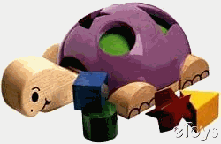
- Toys which require the child to post solid shapes through the correctly shaped hole involve using the whole hand as well as the brain.
- Wooden jigsaws or jigsaws made from chunky card also give a permanent and complete feel to the finished puzzle, which isn't always true of puzzles made from thinner card.
- Some puzzles are made from a plastic foam, which adds a new tactile dimension to the puzzle.
As with the counting frame, plastic shape sorters shouldn't be regarded as 'merely' baby toys. If we take the example of a sorter with a square, a circular and a triangular hole, the children are learning that the circle has an infinite number of axes of rotation (it doesn't matter 'which way up' the circle is, it will still go through the hole), while the square and the triangle have to placed more carefully to get them to fit through their holes.

As the children progress to more difficult puzzles it is useful to provide ones where whole pieces fit into a rigid outline, as then each piece completes a picture without being reliant on the correct positioning of other pieces.
Gradually the children can progress to more conventional puzzles. At first provide puzzles with very few pieces so that the task can be completed before the concentration runs out. Or get the children to complete a larger puzzle in which you have left a few holes to fill.
- When you are choosing a puzzle, look for one with a clear, bold picture, so that the different regions of the finished picture are easy to recognise while the puzzle is still in pieces.
- Try to find puzzles with the pieces cut into different shapes, rather than them all being a regular 'jigsaw' shape. This tends to make the puzzle easier and also allows the children to think about matching a larger variety of shapes.
- The aim of these puzzles may be, for example, to form all the shapes into a rectangle. The puzzles may be made from irregular shapes, animal shapes or geometric shapes, and they have the added dimension of each piece not having a specific front or back.
- These puzzles require the child to think about turning the piece over as well as just rotating it to get it to fit. Dime Puzzles by Tarquin Publications provide a wide range of puzzles of this sort.